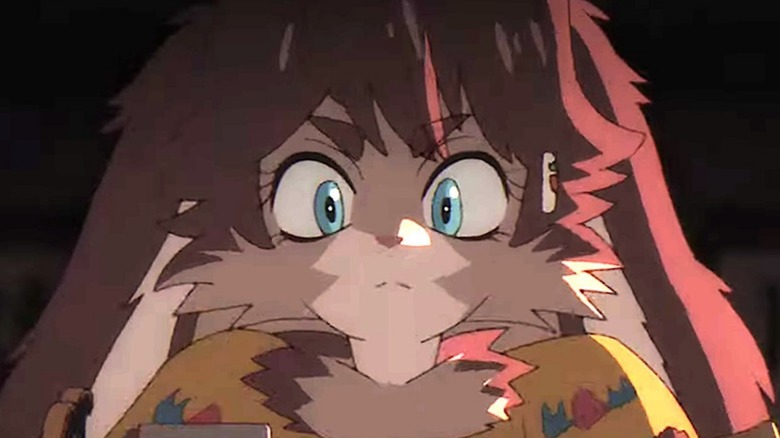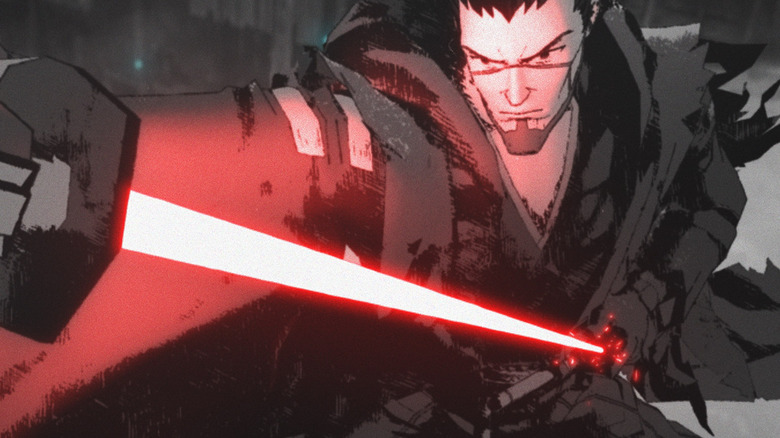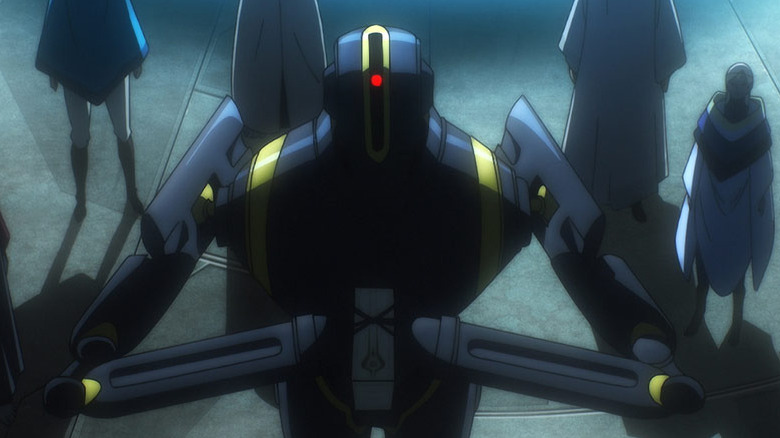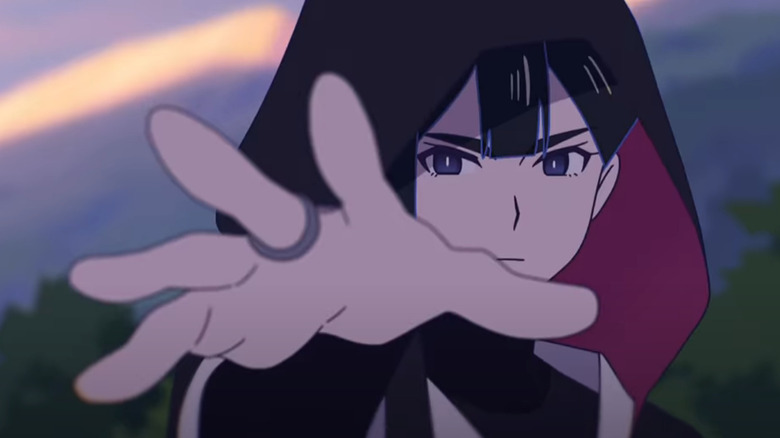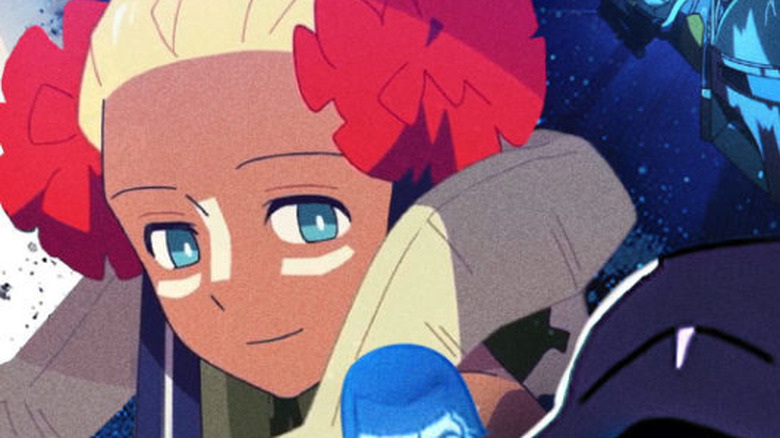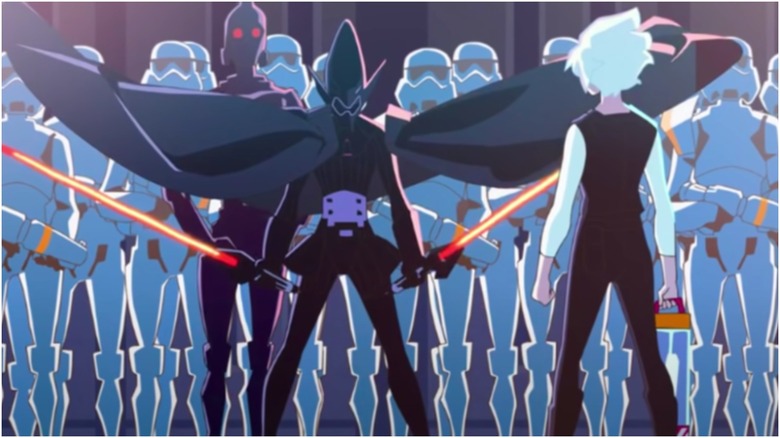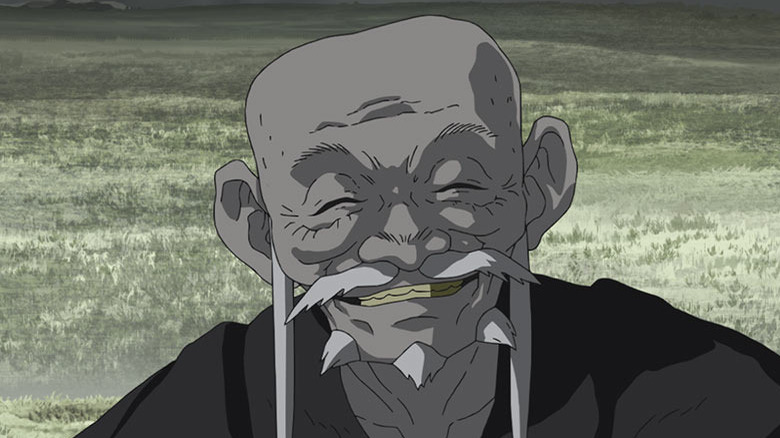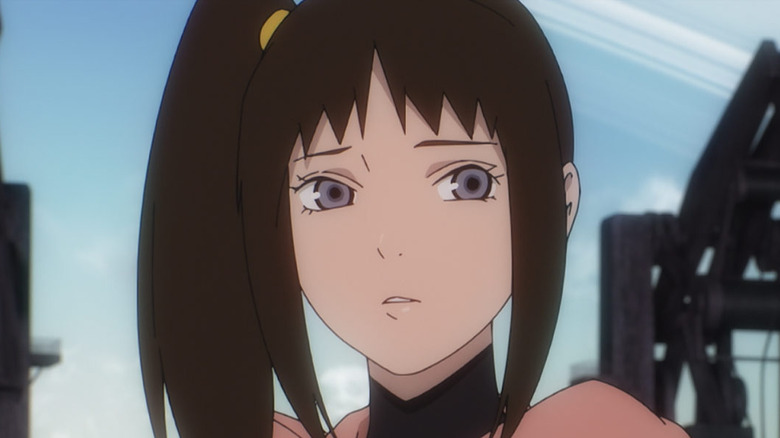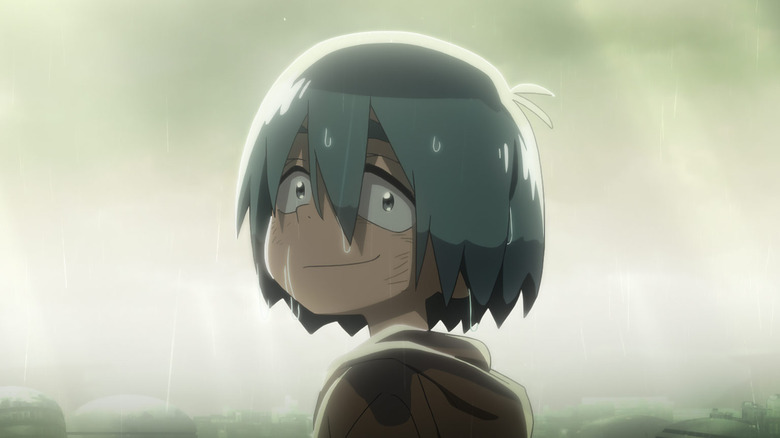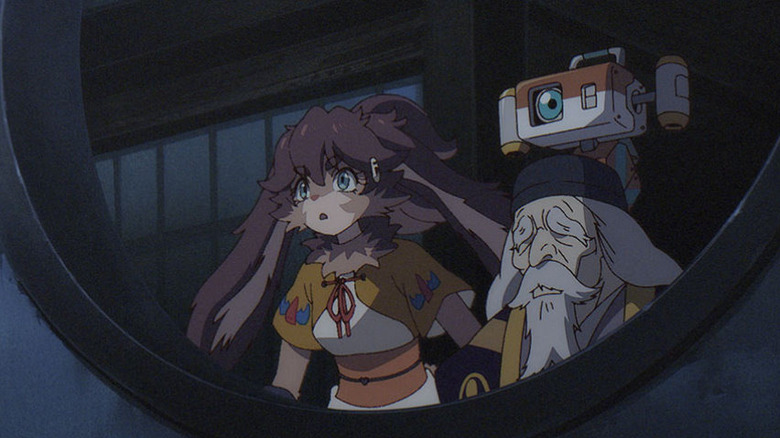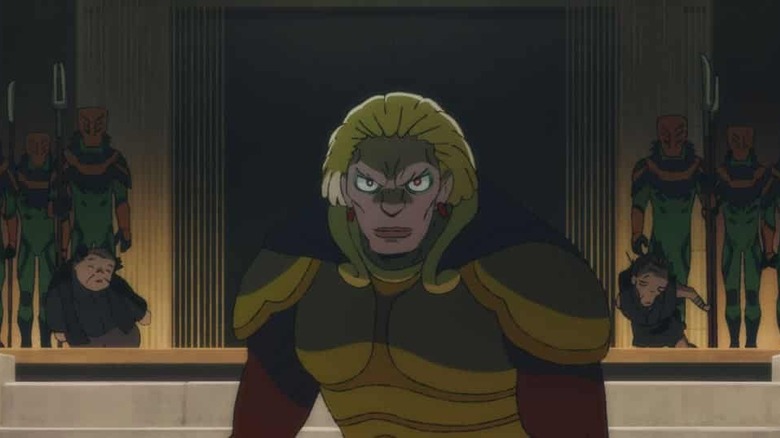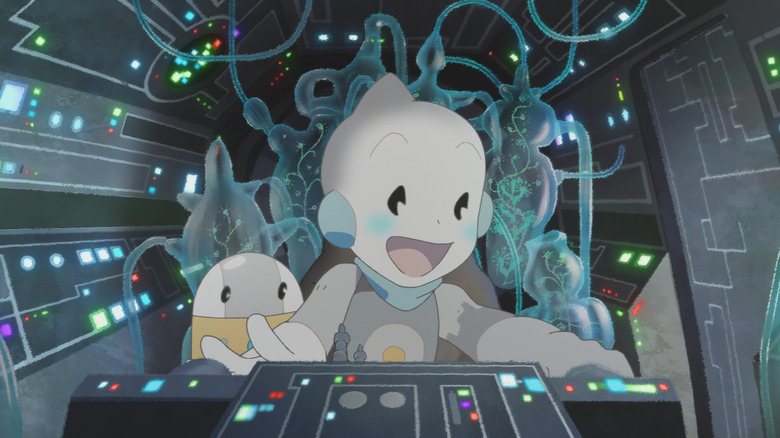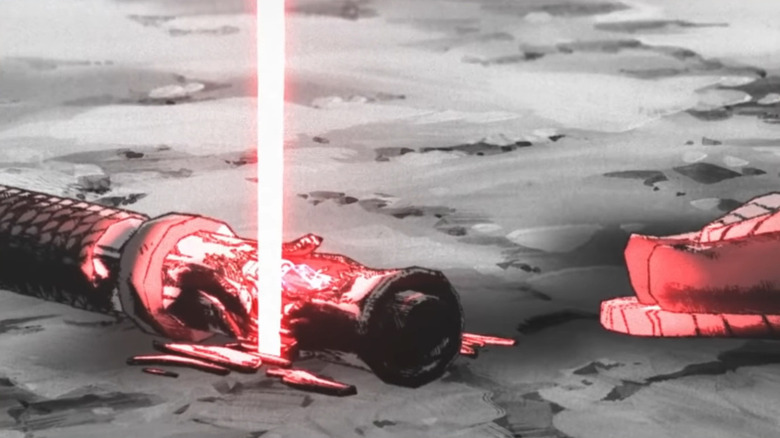The 12 Best Characters In Star Wars: Visions Season 1
Sticklers may be critical of the canonical inconsistency of "Star Wars: Visions," but with this project, adherence to history is less important than acquainting viewers with fresh faces, visuals, and stories that enliven the Star Wars franchise. An anthology consisting of nine shorts made by powerhouse anime studios, the first season of "Star Wars: Visions" pushes the Star Wars universe beyond the live-action universe and Lucasfilm's CG animated series, grounding its stories in the same Japanese cinematic sensibilities that inspired George Lucas in the first place.
Other than a few cameos by Boba Fett, Jabba the Hutt, and some battle droids, "Visions" steers away from familiar faces in favor of remythologizing the world and introducing new characters from both the light and dark (and, possibly, the grey) sides of the Force. Whether they hold lightsabers or not, these are the "Star Wars: Visions" characters who left us wanting more.
The Ronin
Grimed by grizzled shadows thanks to studio Kamikaze Douga's stylized shading, the Ronin is a "Yojimbo"-inspired cipher who walks into a Sith-besieged village in "The Duel." His stern visage, sturdy build, and enigmatic demeanor recall Toshiro Mifune, the star of many of Akira Kurosawa's films and the man who would have played Obi-Wan Kenobi if history had gone differently.
We do not know this guy's deal, but our impressions of him change throughout the short. When he first confronts the Sith, we clock him as a heroic Jedi. But then he flicks on a red lightsaber, and we're as shocked as the Sith he faces. The glow of his saber and the red kyber crystals he collects should set off alarm bells — the villagers certainly seem wary. But the color of the Ronin's blade clashes with his deeds, as he saves the village and hands a child a crystal without any real incentive.
If you watched "The Duel" first, as intended given its place in the "Star Wars: Visions" lineup, the Ronin's final gesture challenges the audience's notions of the Force and kyber crystals and establishes unorthodox expectations for "Visions." Red crystals are omens, but in this case, the blood-red kyber "wards off evil," leaving us to meditate on a radically new interpretation that defies established canon.
Margrave Juro
Even before he pops up on screen, we've been staring straight at Margrave Juro for a while. "The Ninth Jedi" encourages us to be just as skeptical as the Force-users in the room. Is Juro sincere? Is he a Sith, baiting Jedi into a trap? No one knows who the Margrave is, except that he's a ruler who summoned presumed Jedi to a single location in hopes of re-forging the Jedi Order with help from a lightsaber blacksmith — assuming that's true. Only Kara's confirmation that she grew up with the Margrave reveals that Juro is trustworthy.
Juro's determination to restore the Jedi Order does not come without shrewdness and caution. He established extra safety measures in case his gathering is infiltrated by the Sith. Sequestered inside an imposing droid, Juro hides himself in plain sight. But that's not all; Juro planted an agent among the Sith as well. His instincts prove to be vital.
F
A torrent boils in F, as her soulful eyes look over the mask that secludes her jaw. The audience will immediately identify F as a Jedi padawan, thanks to her robes and braid, but she doesn't announce it until her breakthrough. Instead, F starts "Village Wedding" as a soft-spoken observer, a neutral bystander to the grief of villagers terrorized by war and the defilement of their sacred lands. Through flashbacks, we piece together that F lost her master in a tragedy — Order 66 — and went incognito, never lifting her lightsaber again.
But observing the sorrow of the village rekindles her spark, and reminds her what it means to be a Jedi. F may no longer have a Jedi temple to bequeath her a ceremony, so she cuts off her braid and knights herself. From yards away, she charges and swipes her saber, saving the village maiden, Hari. By the time she's taking off to the stars, F is ready to make a new start.
F's intervention saves lost traditions in two ways: She gives the culture of an exploited people a second chance (and, by extension, preserves the culture of her deceased master), while she restores her Jedi practices.
Hari
F may question Hari's methods, but she understands that Hari did the best she could with an under-armed village. Watching Hari strive and make her sacrifice revitalizes F's commitment to the Jedi.
While she's a static character, Hari, the village bride, has just as potent a story as F does. When we first meet her, she does not come off as a lady of action, sequestered in a chair on the back of her betrothed as part of a wedding ritual. Unlike the lightsaber-wielding F, she is not a contemporary Hollywood heroine. But Hari's heroism is understated, and "Village Wedding" implores us to look beyond Hari's surface-level passiveness. The short also allows for measured moments during which we can absorb Hari's gratitude for her surroundings, the remains of her beloved landscape, and her husband's devotion.
When Hari and her fiancé arrive at a sacred stone, the memories projected by her planet tell us about her history; we see Hari and her childhood sweetheart making pathways for fish. We see how she's influenced by Force — or the Magina, in her language. Through these serene peeks into Hari's life, paralleled by the surge of F's fighting spirit, we're encouraged to view Hari's actions as courageous. Glimpses into Hari's past also offer insights into how Hari deals with those who are disheartened when she's taken hostage. For example, when her husband stares contemplatively at a sharpened blade, Hari knows what he's thinking.
Am and Karre
What if the Skywalker twins were born to the dark side? "The Twins" tackles this question. Bred in tubes and raised to serve the dark, Am and Karre are a conspicuous antithesis to Luke and Leia. Karre may not have entirely pure motives, but he does decide to ditch the Empire. Meanwhile, Am remains a fervent follower of the dark side, even after Karre's Force vision reveals that it will destroy her.
Honestly, the contrasting personalities of the sister and brother are less interesting than the visual shorthand used to illustrate their different and changing relationships with the Force, including the conjoined Star Destroyer that externalizes their bond and their hilarious attempts to one-up each other with kyber-fueled ingenuity. Karre improvises with his pilfered kyber crystal and ignites a saber. Am responds by using a crystal to power her suit and brandish six lightsabers, General Grievous-style. Karre wins his round by bisecting a Star Destroyer with his lightsaber and X-wing.
"Twins" might just be the most epic story of sibling rivalry in the galaxy, fueled by Hiroyuki Imaishi's signature overkill style, as also seen in "Kill la Kill" and "Gurren Lagann."
The Old Man
With his raspy voice, yellowed rounded eyes, and demented smirk, the old man glares like a ravenous insect. His history is a blur, but his motive is as clear-cut as his two red lightsabers: He wants to test his skills on a worthy opponent. The old man bears the hallmarks of the dark side — yellow eyes, red blades, Force lightning, knowledge of the Rule of Two, and a grudge against Jedi — which welcomes speculation that maybe he was once affiliated with the Sith (his three-point goatee is a clever nod to Maul's horns). However, he perceives the Sith as obsessed with trying to one-up each other.
For all of his abilities and experience, the old man's folly is his enduring overconfidence and his inability to comprehend his own mortality. In the end, his corpse crumbles into stony dust, contrasting with the Jedi, who take their mortal shells with them when they pass. The old man is nothing more than of a reminder of mortality — the creak of your bones and joints, your waning cognition, and the sag of your flesh are all signs that you'll soon become stardust. As disillusioned as the man was with the Rule of Two, the bond between a Jedi master and his padawan extinguished his hollow life, thus ending his thrill-seeking quest.
Kara
Beaming with the plucky voice of Kimiko Glenn (in the English dub, at least), Kara is cast from the same mold as Luke Skywalker and Rey, other dreamers who look at long-lost creations like lightsabers with wide-eyed wonder. The sprightly, small-framed daughter of a sabersmith, Kara has a natural gift for combat. However, she's still deciding what she wants to be in the world and grapples with her connection to the Force, represented by her transparent lightsabers and their unformed colors.
In "The Ninth Jedi," Kara's father tasks her with delivering the sabers to an assembly of Force users. She discovers that they're secretly Sith and, alongside the Margrave, holds her own in battle and survives.
Kara's journey is only beginning as she departs with the Margrave and his allies to rescue her father — as it turns out, the Margrave is bequeathing her the position of the Ninth Jedi. Kara's innate charm is one of the reasons why fans and critics want a follow-up to the "The Ninth Jedi." She is a beacon of hope for the entire galaxy, and a likable heroine's continuing coming-of-age story is too good an opportunity to pass up.
Jay and Gee
The Hutt Gee and the blue-haired padawan Jay go together like peanut butter and blueberry jelly. Jay comes running into Gee's life as a timid Jedi on the run from Order 66. Disgruntled with Jabba's enterprise, Gee has slithered away from the Hutts' legacy in order to become a solo musician. Together, Gee and Jay form a bond, bolstered by their merry band of misfits. If only Boba Fett would let the band finish its set!
For all of Jay's Shaggy-like timidity, he's not a coward, just an underdeveloped soul finding his voice. Throughout "Tatooine Rapsody," Jay is repeatedly eying his lightsaber. Tellingly, the weapon fizzles out when he attempts to use it in violent confrontations — it's responding to his downcast spirit. Jay thinks that he has to reclaim his Jedi heritage through the blade. But, in the end, he realizes that the violence is no longer the legacy he wants, nor the one that serves his survival the best.
And so, Jay modifies his lightsaber, turning it into a glowing microphone. First, it looks like the device is designed for smuggling purposes, paving the way for a Luke Skywalker-style rescue in front of Jabba's crowd. But Jay never wields the altered saber like Jedi do. Instead, it symbolizes his bold singing voice, letting his band live another day without the need for combat.
Lop and Ocho
"Lop and Ocho" centers on the disintegration of bonds between siblings. Designed as a shout-out to Expanded Universe favorite Jaxxon, the rabbit-like Lop is the fuzziest and cuddliest of Star Wars heroines. You want to give her a hug because the Empire took away her family not once, but twice — first her biological parents, and then her adopted human sister, Ocho.
Ocho is a tragic figure, a sweet and compassionate girl who becomes a ruthless traitor and servant of the evil Empire. Inflamed with a zealous allegiance to her family, Ocho chops off her braid and convinces herself that joining the Empire, with its promises of industrial advances, is the key to her clan's salvation.
Found family, adopted siblings, and broken family bonds are not novel ideas in Star Wars, but the cracks in Lop and Ocho's sisterhood introduce a dynamic that's not normally seen on screen. This is compounded by the short's moral, which posits that bloodlines do not define family bonds. One sister is born into the family and one isn't, and yet it's Lop who ends up accepting the heirloom that could help her fend off her sister. Lop clings to the belief that there is still good in Ocho, and that she can be saved. Like Lop, you hope Ocho that comes to her senses, but know that it won't happen anytime soon.
Masago the Sith
The murderer of her kingly brother, Masago operates as the final boss of "Akakiri," and her machinations close "Star Wars: Visions" Season 1 on a pessimistic note. Like every good Sith, Masago is an imposing presence, with her hulking stature and shrewd mind. "Akakiri" frequently ruminates on fate, and wonders if destiny could be reversed. Masago herself preaches predestination — "[My brother the king] was always going to die, because it was written," she says – while offering a forbidden fruit: a way out through the dark side. Arguably, Masago doesn't believe in fate as much as she has the confidence and swagger to use it as a tool to sway things in her favor.
It required secrecy and deviousness to train as a hidden Sith among royal family members. Masago's cunning involves preying on the Jedi Tsubaki's insecurities over his Force visions. She overwhelms the Jedi with her army, then Force-puppeteers his friend Misa, causing Misa to be struck down by his saber. Finally, Masago uses Tsubaki's desperation and grief to make him compromise his Jedi values and swear loyalty to her. It takes careful planning, but in the end, Masago walks away with both a sworn apprentice and newfound power.
T0-B1
Can a droid become a Jedi? This is the dream of T0-B1 — also known as Tobi — the young assistant of Master Mitaka, an Obi-Wan Kenobi-like Jedi. Luckily, T0-B1 was already under the tutelage of Mitaka, who was secretly shaping the droid into his padawan. T0-B1 is a great candidate, too; his cute rolls and handstands as he vies for his own lightsaber are as dreamy as anything young Anakin Skywalker got up to.
T0-B1's desire to be a Jedi is initially fueled by a search for thrills. But after Mitaka's death, he understands the importance of protection, growth, and the cycle of life, and fulfills Mitaka's quest to enliven a wasteland planet with greens. T0-B1 is an interesting Pinocchio-esque take on the "robot searching for its own humanity" trope, since he dreams of being not a robot with a saber, but a flesh-and-blood human Jedi.
Unless you count the non-canon story of Skippy the astromech, T0-B1 receives something that no other droid has received in the Star Wars universe: Force abilities. But "T0-B1" takes it further, insisting that a soul like T0-B1 is welcome on the Force's cosmic plane. On the surface-level, T0-B1's design hearkens back to Astro Boy, with a heavy Disney influence. But Astro Boy also has a history as an advocate for robot rights, suggesting that T0-B1 is a step towards giving dignity to the downtrodden and maligned droids of the Star Wars galaxy.
Kyber Crystals
By the time that the Ronin tells a village child, "This wards off evil," and bequeaths him a red kyber crystal, a traditional symbol of the Sith's evil, Star Wars fans know they're in for something different and remarkable with "Visions."
"Visions" offers small, non-invasive cameos from Jabba and Boba Fett, but the familiar characters that receive the biggest makeover in the series are none other than the spiritual batteries of the Jedi and Sith's weapons, the kyber crystals. At the most basic level, the crystals in "Star Wars: Visions" reshape the lightsabers made famous by Star Wars, adding skittering sound effects, powering parasol-like weapons, sharpening the laser blades into cutting katanas, and unleashing their full power to cut a Star Destroyer in half. In "Tatooine Rhapsody," a disgraced padawan re-forges his saber into a glowing microphone, showing that his voice is all he needs to survive. In "The Ninth Jedi," kyber crystals yield colorless blades that burst with different hues according to the wielders' allegiances and inner natures.
The kyber crystals' relationships with different characters' souls also subverts Star Wars' old ways. In "T0-B1," a kyber crystal connects the Force with a childlike droid who has no Midi-chlorians in his blood. "Ocho and Lop" uses a kyber crystal passed across generations to show that families are not defined by bloodlines. Kybers are beacons for hope, as illuminated in the final, inverted shot of "The Ninth Jedi." They bind both us and the shorts of "Star Wars: Visions" to the Force.
